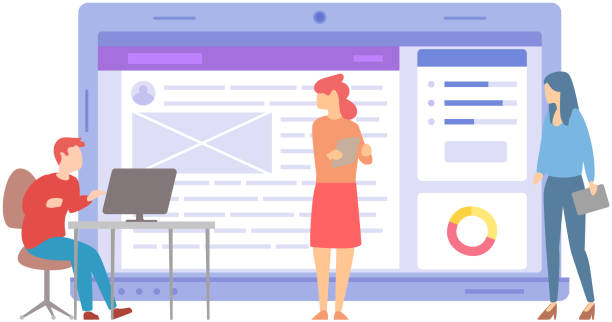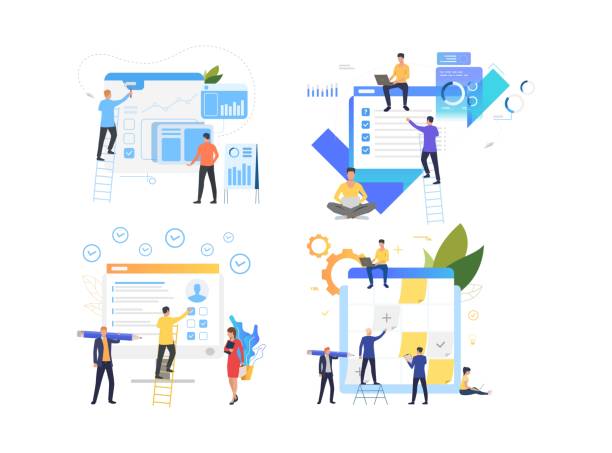The Fundamental Importance of Secure Website Design for Online Businesses

In today’s digital world, where every business relies on an online presence for survival and growth, #secure website design is no longer an option, but an undeniable necessity. Websites, as the main showcase for businesses in virtual space, are places for exchanging sensitive customer information, conducting financial transactions, and providing various services.
Any security flaw can lead to loss of user trust, data theft, damage to brand reputation, and even irreparable financial losses.
For this reason, a proactive approach in secure website design is of vital importance.
This approach includes identifying potential vulnerabilities, implementing strong defense mechanisms, and continuously updating security protocols.
Necessary training in this field and understanding the current challenges of cyberspace are essential for every developer and online business owner.
This section explains the importance of this topic and provides a basis for more specialized discussions in later chapters.
Protecting user information, ensuring service stability, and preventing malicious attacks all require special attention to the principles of website security from the very beginning of the design and development process.
Does your current corporate website not reflect your brand’s credibility and power as it should? Rasaweb solves this challenge for you with professional corporate website design.
✅ Increase visitor credibility and trust
✅ Attract more targeted customers
⚡ Click for free consultation!
Familiarity with Common Website Security Threats and Countermeasures

To achieve a secure and successful #website design, a precise understanding of the cyber threats targeting websites is the first and crucial step.
This section specifically and analytically examines the most common attacks.
One of the most dangerous threats is SQL Injection attacks, where an attacker can gain access to sensitive information or alter it by injecting malicious SQL codes into the database. Cross-Site Scripting (XSS) attacks also allow an attacker to execute malicious JavaScript codes in the victim’s browser, which can lead to cookie theft or login information.
Distributed Denial of Service (DDoS) attacks disrupt website services by sending a huge volume of traffic to the server.
In addition, attention must be paid to other vulnerabilities such as Broken Authentication, Insecure Deserialization, and security Misconfigurations.
To counter these threats, the use of Web Application Firewalls (WAF), input validation, the use of secure protocols like HTTPS, and regular updates of software and libraries are essential.
Understanding the depth of these threats and designing multi-layered defense systems is the cornerstone of a secure website design and a reliable one.
Principles of Secure Coding and Best Practices for Developers

One of the most important pillars of #secure website design is adherence to secure coding principles. This section, in an educational and guiding manner, helps developers minimize common vulnerabilities in their code by following best practices.
The first step is thorough validation of all user inputs.
This action prevents SQL injection, XSS, and Directory Traversal attacks.
Using Prepared Statements in database communication is crucial to prevent SQL Injection.
Also, ensure that outputs are escaped when displayed in HTML to counter XSS.
Proper error and exception handling is also very important; displaying generic error messages to the user and logging error details on the server, instead of exposing sensitive system information, is a principle of secure coding.
Session Management must also be performed carefully; using long session tokens and not storing sensitive information in cookies is highly important.
To help developers in this regard, the table below briefly shows some of the best practices:
| Area | Security Method | Brief Description |
|---|---|---|
| Inputs | Validation and Filtering | All user inputs must be checked and sanitized for type, length, and content. |
| Database | Prepared Statements | To prevent SQL Injection, never directly embed user input into SQL queries. |
| Outputs | Escaping | Convert special characters in HTML/XML outputs (to prevent XSS). |
| Session Management | Session Hijacking Prevention | Use long and random tokens, reset tokens after user login and logout. |
| Error Handling | Information Disclosure Prevention | Display generic error messages to the user and log details in server logs. |
| Encryption | Use Strong Algorithms | For storing sensitive information and passwords, use strong hashing algorithms and Salting. |
Developers must continuously update their knowledge of web security and use frameworks and libraries that have security mechanisms implemented by default. This proactive and specialized approach is the foundation of a secure and reliable website.
User Data Protection: A Fundamental Pillar of Secure Website Design

In the information age, protecting user data is one of the most important responsibilities in #secure website design, and undoubtedly, the sensitivity of this issue is of particular importance. Any negligence in this area can lead to privacy breaches, identity theft, and complete loss of user trust.
This section explains and specializes in key solutions in this area.
The first step is to use the HTTPS protocol to encrypt communication between the user’s browser and the server.
This prevents eavesdropping on information in transit.
The second step is proper data encryption during storage, especially sensitive information such as passwords, credit card numbers, and identity information.
Using strong hashing algorithms (such as bcrypt or Argon2) for passwords and preventing the storage of passwords in clear text is highly important.
In addition, attention must be paid to data protection laws and regulations such as GDPR in Europe or CCPA in California, and transparent privacy policies must be provided to users.
Restricting data access only to authorized users and systems (Least Privilege Principle), cleaning unnecessary data, and regular and encrypted backups of information are other vital components for a secure website design.
Did you know that a weak corporate website takes many opportunities from you daily? Solve this problem forever with professional corporate website design by Rasaweb!
✅ Create a powerful and reliable image for your brand
✅ Attract targeted new customers and increase sales
⚡ [Get Free Website Design Consultation]
Server and Infrastructure Security: Prerequisite for a Robust Online Platform

Server and infrastructure security forms the backbone of #secure website design, and without it, all efforts in higher layers will be futile. This section specifically and in a guiding manner addresses the importance and solutions for securing servers and the hosting environment.
The first step is regular updates of the operating system, web server, database, and other software in use.
Many attacks occur through known vulnerabilities in outdated software.
Second, proper configuration of firewalls and the use of Web Application Firewalls (WAF) to filter malicious traffic and block common web attacks.
Managing access at the server level, using SSH keys instead of passwords, and restricting remote access are highly important.
Disabling unnecessary services on the server and changing default ports can also reduce the attack surface.
Continuous monitoring of server logs to identify suspicious activities and implementing Intrusion Detection Systems (IDS) and Intrusion Prevention Systems (IPS) are other vital measures in the path of server hardening.
Strong Authentication and Authorization: The Ultimate Fortress for User Account Protection

In the process of #secure website design, Authentication and Authorization systems play a vital role in protecting user accounts and sensitive data.
This section, in an educational and guiding manner, examines the best practices for creating a secure login system. The first step is to compel users to use strong and complex passwords that combine uppercase and lowercase letters, numbers, and special characters.
Educating users about the importance of strong passwords and preventing password reuse across different sites is very important.
Implementing Two-Factor Authentication (2FA) or Multi-Factor Authentication (MFA) adds a powerful security layer to accounts, making attacker access difficult even if passwords are exposed.
On the other hand, the Authorization system ensures that users only have access to resources they are permitted to view or edit (Role-Based Access Control – RBAC).
This includes precise control over access to files, folders, and administrative functions on the website.
Logging and monitoring unsuccessful login attempts to identify Brute-Force attacks and locking suspicious accounts are also highly important.
The Importance of Periodic Security Audits and Penetration Testing for Online Websites

After the initial implementation of #secure website design, the work is not over; rather, periodic Security Audits and Penetration Testing are vitally important for identifying and addressing new vulnerabilities. This section specifically and in a guiding manner addresses the why and how of performing these evaluations.
A security audit is a comprehensive review of all security aspects of a website, from code to server infrastructure and network configuration.
This process can include manual code review, automated vulnerability scans, and security policy evaluation.
The main goal is to identify weaknesses before attackers discover them.
Penetration testing goes a step further and simulates real cyberattacks performed by security professionals (White Hat Hackers).
These tests attempt to penetrate the system in a controlled manner and prove vulnerabilities in practice.
This analytical and practical approach helps organizations discover unknown weaknesses and fix them before attackers exploit them.
The result of penetration tests usually includes a detailed report of vulnerabilities, their risk level, and suggested solutions to address them.
For a better understanding of the difference and importance of these two approaches, see the table below:
| Feature | Security Audit | Penetration Test |
|---|---|---|
| Main Goal | Identify vulnerabilities and general weaknesses | Simulate real attacks to discover exploitable vulnerabilities |
| Approach | Comprehensive review of system, policies, configuration, and code | Attempt to bypass defense mechanisms and gain unauthorized access |
| Tools | Vulnerability scanners, code analysis tools, checklists | Ethical hacking tools (e.g., Metasploit, Nmap, Burp Suite) |
| Output | List of vulnerabilities, policy improvement suggestions | Detailed report of exploits, penetration paths, practical recommendations |
| Frequency | Periodic (e.g., annually or after major changes) | Periodic (e.g., annually, after major changes, or discovery of critical vulnerabilities) |
Regularly performing these tests is an inseparable part of the lifecycle of a secure and stable website design and assures businesses that they are protected against new threats.
Security Incident Response and Data Recovery: Crisis Management Strategy

Even with the best #secure website design, the probability of a Security Incident never reaches zero.
Therefore, having a comprehensive Incident Response Plan and a Disaster Recovery strategy is vitally important for any organization. This section, in a guiding and informative manner, addresses the necessary actions when facing a security crisis.
An effective incident response plan includes the stages of incident identification, containment, eradication, recovery, and post-incident analysis.
In the identification phase, tools and processes must be in place for rapid detection of anomalies and security breaches.
After identification, the main goal is to contain the attack and prevent its spread.
Eradication involves completely removing the attack vector from the system.
Then, the recovery process begins, which includes restoring systems and data to a normal and secure state.
Finally, post-incident analysis helps understand how the incident occurred and how to prevent its recurrence in the future.
Regular and encrypted backups of data and systems are the cornerstone of information recovery.
Backups must be kept in a secure location separate from the main server.
This proactive and reactive approach ensures that even in the worst-case scenario, the business can quickly recover and return to normal operations, and this itself is an inseparable part of a comprehensive secure website design.
Are you falling behind in the competition with large online stores?
Rasaweb, with professional e-commerce website design, brings your business online and increases your market share!
✅ Increase brand credibility and customer trust
✅ Easy shopping experience leading to more sales
⚡ Act now to get free website design consultation!
New Developments and Challenges in Web Security and the Future of Secure Website Design

The world of cybersecurity is rapidly evolving, and every day we witness the emergence of new threats and technologies.
Understanding these developments is essential for maintaining #secure website design in the future. This section analytically and with thought-provoking content addresses the challenges and future trends in web security.
With the expansion of the Internet of Things (IoT), Artificial Intelligence (AI) and Machine Learning (ML), the attack surface for websites also becomes more complex.
Attackers use AI to automate attacks, identify vulnerabilities, and even generate more sophisticated malware.
In contrast, AI and ML are also becoming powerful cybersecurity defense tools; from detecting anomalies and Zero-Day attacks to automating incident response.
One of the biggest challenges is API security (Application Programming Interfaces), as many modern web applications widely use APIs to communicate with other services.
Attacks on APIs can lead to data theft or system control.
The question is, how can we keep pace with this speed of change and ensure the security of our online platforms? Focusing on Microservices and Serverless architectures, along with adopting the “Zero Trust” security model, can be helpful.
These developments indicate that secure website design is not a static process, but a continuous path of learning and adaptation.
Continuous Security and Continuous Improvement: The Ultimate Solution for Secure Website Design

Ultimately, to achieve a sustainable and successful #secure website design, a continuous improvement approach must be adopted. This section analytically and in a guiding manner explains the importance of continuous security.
Website security is not a one-time project, but an ongoing process that requires continuous attention and investment.
This means that after implementing the basic principles, systems must be regularly reviewed, updated, and strengthened.
Conducting continuous training courses for the development team on the latest threats and best secure coding practices is essential.
Sharing security information with the community and collaborating with other security professionals can help you stay informed about the latest vulnerabilities and countermeasures.
Using automation tools for automated security scans and continuous monitoring can help identify issues early.
Also, creating a strong security culture within the organization, where every employee is considered responsible for security, is highly important.
This includes educating employees about the risks of phishing, social engineering, and the importance of maintaining confidential information.
Ultimately, secure website design is a long-term commitment that, through continuous evaluation, adaptation to changes, and continuous improvement, can ensure user stability and trust in the digital world and significantly help maintain your website security against growing threats.
Frequently Asked Questions
| Row | Question | Answer |
|---|---|---|
| 1 | What is secure website design? | Secure website design is a process in which websites are built with security measures in mind from the early stages of development to be protected against cyberattacks, unauthorized access, and data loss. |
| 2 | Why is secure website design important? | Website security is crucial for maintaining user trust, protecting sensitive information (personal and financial), preventing damage to brand reputation, and complying with privacy and security regulations (such as GDPR). A security breach can lead to financial and legal damages. |
| 3 | What are the most common cyberattacks a website faces? | Some of the most common attacks include SQL Injection, Cross-Site Scripting (XSS), Distributed Denial of Service (DDoS), Brute Force, and attacks based on authentication information (Credential Stuffing). |
| 4 | What is SQL Injection and how to prevent it? | SQL Injection is a type of attack where an attacker attempts to manipulate the database or extract information by injecting malicious SQL codes into website inputs. To prevent it, one should use Prepared Statements/Parameterized Queries, ORM (Object-Relational Mapping), and thorough input validation. |
| 5 | What is Cross-Site Scripting (XSS)? | XSS is a type of attack where an attacker injects malicious scripts (usually JavaScript) into web pages that are executed by other users’ browsers. This can lead to the theft of cookies, session information, or alteration of the website’s appearance. |
| 6 | How can Brute Force attacks on login pages be prevented? | To prevent Brute Force attacks, one should use CAPTCHA, limit the number of unsuccessful login attempts (Account Lockout), Two-Factor Authentication (2FA), and employ complex and long passwords. |
| 7 | What is the role of HTTPS in website security? | HTTPS encrypts the communication between the user’s browser and the website server using SSL/TLS. This prevents eavesdropping, tampering, or forging of information during transmission and increases user trust. |
| 8 | What is the importance of Input Validation in security? | Input validation is the process of checking and sanitizing data entered by the user. This prevents the injection of malicious code, XSS attacks, SQL Injection, and other vulnerabilities, and ensures that the data is in the expected format. |
| 9 | Why is regular updating of website systems and software necessary? | Regularly updating the operating system, CMS (like WordPress), plugins, themes, and libraries in use addresses known security vulnerabilities. Hackers often exploit weaknesses in outdated software for intrusion. |
| 10 | What role do regular backups play in secure website design? | Regular and tested backups of website data (database and files) are a vital layer of defense against data loss due to cyberattacks, human errors, or hardware failures. This allows for quick website recovery in case of a disaster. |
And other services of Rasa Web Advertising Agency in the field of advertising
Smart Advertising Campaign: An effective tool for campaign management by customizing user experience.
Smart Custom Software: A combination of creativity and technology for analyzing customer behavior using real data.
Smart Reportage: A new service for improving SEO ranking through optimizing key pages.
Smart Customer Journey Map: A combination of creativity and technology to increase sales through custom programming.
Smart Marketing Automation: A dedicated service for digital branding growth based on key page optimization.
And over a hundred other services in the field of internet advertising, advertising consultation, and organizational solutions
Internet Advertising | Advertising Strategy | Advertorial
Resources
- Website Security and Ways to Increase It
- How to Design a Secure Website?
- Secure Website Development Guide
- Website Security: From Zero to Hundred
? Are you ready for your business to soar with fast website design and professional digital marketing strategies? Rasaweb Afarin Digital Marketing Agency is your reliable partner on the path to online growth and success. With an innovative and creative approach, we create a powerful and memorable presence for your business in the digital world. Build your business’s future with us.
📍 Tehran, Mirdamad Street, next to Bank Markazi, Southern Kazeroon Alley, Ramin Alley, No. 6




